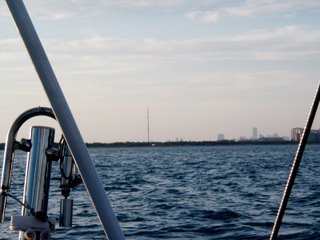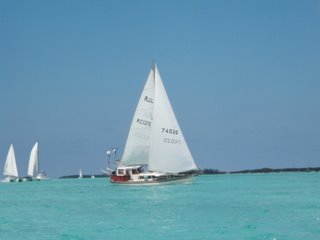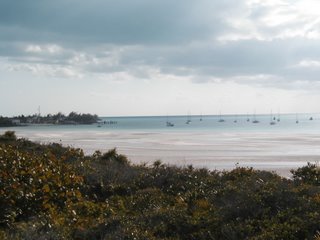Back to MiamiThe first week of April saw us on our way back to Miami, with a brief stop in Warderick Wells to enjoy a swim and snorkel off the beaches and a hike across the island from the “bank” side to the “sea” side. Then we set sail across one bank, across the deep waters of Tongue of the Ocean that divide them and across the bank on its west side to North Cat Cay. Winds were light and sometimes blowing from the direction we were trying to go in, which made the journey a little longer than we had anticipated - such is sailing. After we crossed Tongue of the Ocean the wind shifted - it decided to blow from the direction we were going in. That had us tacking back and forth, and we decided stopping for the two nights we were on the bank and continuing on during the day was safer than sailing on in the darkness. Our second stop was just off North Cat Cay on the western edge of the Bahamas, where we arrived late and spent a bumpy night. That meant being up early was no challenge, and as soon as it was daylight we went through the narrow cut there and headed for the Gulf Stream and Miami. By that evening we were in U.S. waters, entering Biscayne Bay through the cut off Cape Florida in time to anchor for the night in the Bay. Next morning we called in, welcomed personnel from Homeland Security on board for a brief visit, and replaced our Q flag with the Stars and Stripes. By that evening we had had our passports officially stamped, and we were on our way to visit family. Then it was time to settle in for some more serious work to get ready for our next voyage.
Working on Into The Blue - Some More.Most of April and half of May saw us hard at work. Our largest project was putting together a Jordan Series Drogue, something we decided we would rather have to help us in very heavy weather instead of wishing we had it should we ever need it. We saved some time by ordering a Sailrite kit with the one hundred cones we needed already cut. Then it was just a matter of cutting and sewing three hundred pieces of tape on to the one hundred cones and sewing the cones together; attaching those pieces of tape to umpteen feet of rope (each piece of tape knotted top and bottom through the rope); making the necessary splices; and attaching stainless steel brackets to the stern to fasten the drogue to. Other jobs were smaller - working on improving radio transmission, creating covers for the bins in the main cabin, raising the port berth in the main cabin to create chart storage underneath it, making sure that we can fasten down the floorboards and ice box lids should we need to, making baggywrinkles for our aft shrouds to prevent the mainsail from chafing when we are going downwind (bright yellow for now until the sun mellows them, they are nice and cheerful), and generally doing whatever we could think of to increase comfort and safety while under way. At the same time we were reprovisioning and stowing, bit by bit, and the boat was sinking lower and lower on her water line.
We spent days at a time in Hurricane Harbor, surrounded by large houses and protected not just from the weather but from much of the traffic on Biscayne Bay. Any weekends we were there we were joined by a few other boats, and saw many others tour through, but generally there was little activity during the week. When we wanted to spend time with family, we left the boat on a mooring in Crandon Park Marina and locked our dinghy into the dinghy stand. When we just needed to go to the grocery store then we spent the day in No Name Harbor, and biked in from there - Richard also made a couple of long bicycle trips into Miami from there, to get work done or pick up marine supplies.
As the middle of May drew near, we took stock of what we had done and decided it was time to go. Boat work never actually finishes - you just get used to doing it wherever you happen to be. But you do try to do the larger jobs where it is most economical, and hope that nothing too big sneaks up on you anywhere else. So - supplies bought and stowed and plans made, we lingered just long enough to celebrate Mother’s Day with family, including one daughter. Then we waited through thunderstorms and northerly winds, until the day the weather changed and the winds blew out of the south and the Gulf Stream showed its friendly face...
Bermuda Bound.We set off on a friday evening, leaving Cape Florida behind us as the sun was going down in the sky. The winds were light and stayed light for the next four days, but at least we had the Gulf Stream to help us northward past the Bahamas. Then the winds grew brisker and we adapted to living life more or less at an angle. We tuned in to Herb on South Bound II to help us find friendly winds and currents and avoid any heavier weather. The days passed quickly, what with log keeping, standing watches, preparing meals, looking out for ships and figuring out where they were headed. We created our own routine, which suited our own sleeping habits...
When you look out over the blue of the ocean it is easy to feel that there is no-one else around. Then a freighter or cruise ship comes into view, or you hear on the net that there is another boat travelling close to you, going in the same direction. In our case there was Lapwing, a Valiant 40 - we talked to them once or twice a day on our SSB radio, comparing conditions and discussing our next waypoints. They arrived in Bermuda a day ahead of us, having decided to motor while we kept sailing, and were waiting to greet us when we got here.
Other less pleasant things remind you of the presence of man. We passed an array of things floating in the sea - from the drawers of a bureau to balloons to a yellow jerry can to plastic bottles and bits of foam to parts of crates and other wooden debris. We heard one boat radio in to the net that they had passed a semi-sunken powerboat, bow bobbing along above the waves.
Other creatures that travel and live on the sea are less intrusive. You have to take the time to look for the Petrels that skim low over the water, searching for food. The Portuguese Man-of War jellyfish sail quietly past. The dolphins catch your attention with the sound of their breathing, sometimes off in the distance, sometimes right by the boat. Most of the time they are in groups, but sometimes there is just one swimming along by itself. Two days in a row a Tropicbird came to look us over and try to land on our mast. The rope for the topping list, snapping around, and the array of things on top of our mast defeated him. He sounded indignant as he flew away.
A week and a half later we were approaching Bermuda. Since it is a set of islands surrounded by reefs, the approach to Bermuda demands respect and attention to charts and navigation. And once you are thirty miles or so off the coast every boat is expected to call in to Bermuda Radio on 16, and give details of their position, the size and type of vessel, the number of persons and safety equipment aboard and their estimated time of arrival off the cut which leads in to the harbour in St. George. Should you fail to do so, Bermuda Radio will hail you - and they will follow up should you not arrive at the time given. Once you are close to the cut, they will let you know whether you can enter or must wait for cruise ship traffic; once inside they guide you to the dock where you tie up to clear customs - or ask you to anchor off and wait. All very different from the Bahamas - and these are not the only differences we have been finding. But that is for next time...
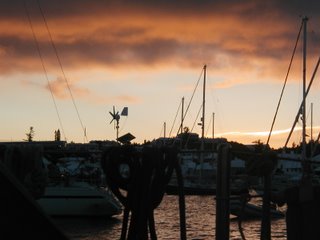 The sun is setting over St. George and the anchorage is filled with boats waiting for a good opportunity to continue their voyages. Some, like us, are going to Horta in the Azores, others are en route to the United States or the Canadian East Coast. There are flags from Britain, France, Denmark, Germany, St. Kitts/Nevis, flown on sloops, yawls, ketches and even schooners of all sizes.
The sun is setting over St. George and the anchorage is filled with boats waiting for a good opportunity to continue their voyages. Some, like us, are going to Horta in the Azores, others are en route to the United States or the Canadian East Coast. There are flags from Britain, France, Denmark, Germany, St. Kitts/Nevis, flown on sloops, yawls, ketches and even schooners of all sizes.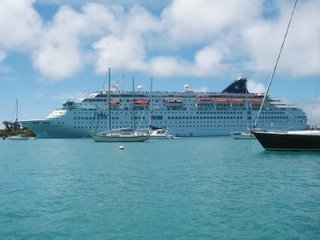 Small cruise ships also moor in St. George (as in only ten storeys or so high). They are one of the reasons that Bermuda Radio monitors all arrivals and departures - no other vessels is going to be able to transit the main cut into the harbour when one of these is going in or out.
Small cruise ships also moor in St. George (as in only ten storeys or so high). They are one of the reasons that Bermuda Radio monitors all arrivals and departures - no other vessels is going to be able to transit the main cut into the harbour when one of these is going in or out. These dinghies were racing out of the East End Mini Yacht Club (in the pink building), through the cruising boats and across the harbour. They looked as if they were thoroughly enjoying themselves.
These dinghies were racing out of the East End Mini Yacht Club (in the pink building), through the cruising boats and across the harbour. They looked as if they were thoroughly enjoying themselves. From St. George we walked to Fort St. Catherine. On the way we passed beaches and there was a golf course that the roads ran through. The road going up to the Fort overlooked this small beach and gave us a different view of the other roads we had walked along.
From St. George we walked to Fort St. Catherine. On the way we passed beaches and there was a golf course that the roads ran through. The road going up to the Fort overlooked this small beach and gave us a different view of the other roads we had walked along. All kinds of people ride scooters - all ages, shapes and sizes. Bermudans on their scooters seem so comfortable that it looks as if they were born riding them...
All kinds of people ride scooters - all ages, shapes and sizes. Bermudans on their scooters seem so comfortable that it looks as if they were born riding them... In the middle of this picture is one of the Fitted Dinghies, with its long bowsprit, large sails and low freeboard (sides). Six is the standard number aboard, necessary to keep the boat as level as possible and bail when needed - which seems to be often.
In the middle of this picture is one of the Fitted Dinghies, with its long bowsprit, large sails and low freeboard (sides). Six is the standard number aboard, necessary to keep the boat as level as possible and bail when needed - which seems to be often.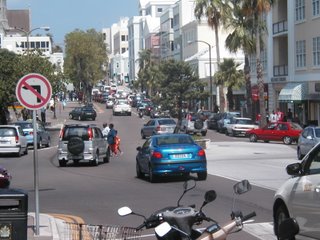 Downtown in Hamilton, capital of Bermuda, on a Saturday morning. There are lots of cars and scooters on the streets, and pedestrians on the sidewalks. People are out shopping and looking; for the young people we saw it seemed to be a "see and be seen" kind of day and place.
Downtown in Hamilton, capital of Bermuda, on a Saturday morning. There are lots of cars and scooters on the streets, and pedestrians on the sidewalks. People are out shopping and looking; for the young people we saw it seemed to be a "see and be seen" kind of day and place.




